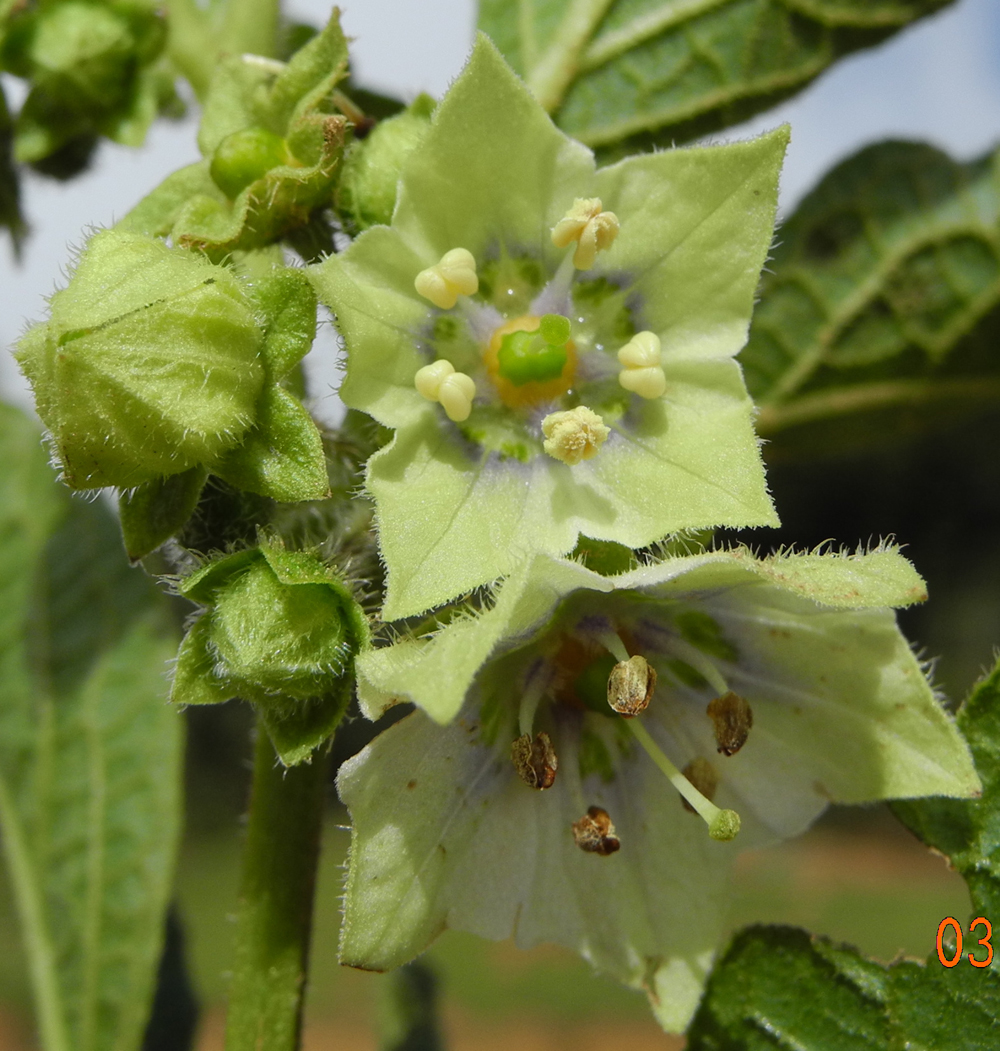 |
| Figure 1. Jaltomata cuyasensis. In the upper flower note the stigma (in focus at center) connected by style to ovary; . Note the nectar at the base of the corolla in the upper flower. In the upper flower three anthers remain undehisced while two (top and bottom) have dehisced. In the lower flower note that all five anthers have dehisced, and on the stigma a shallow medial groove is evident. Towards the upper left we can see a flower bud that would open the next day. Photo by T. Mione, March 2011, Mione, Leiva G. and Yacher 806. |
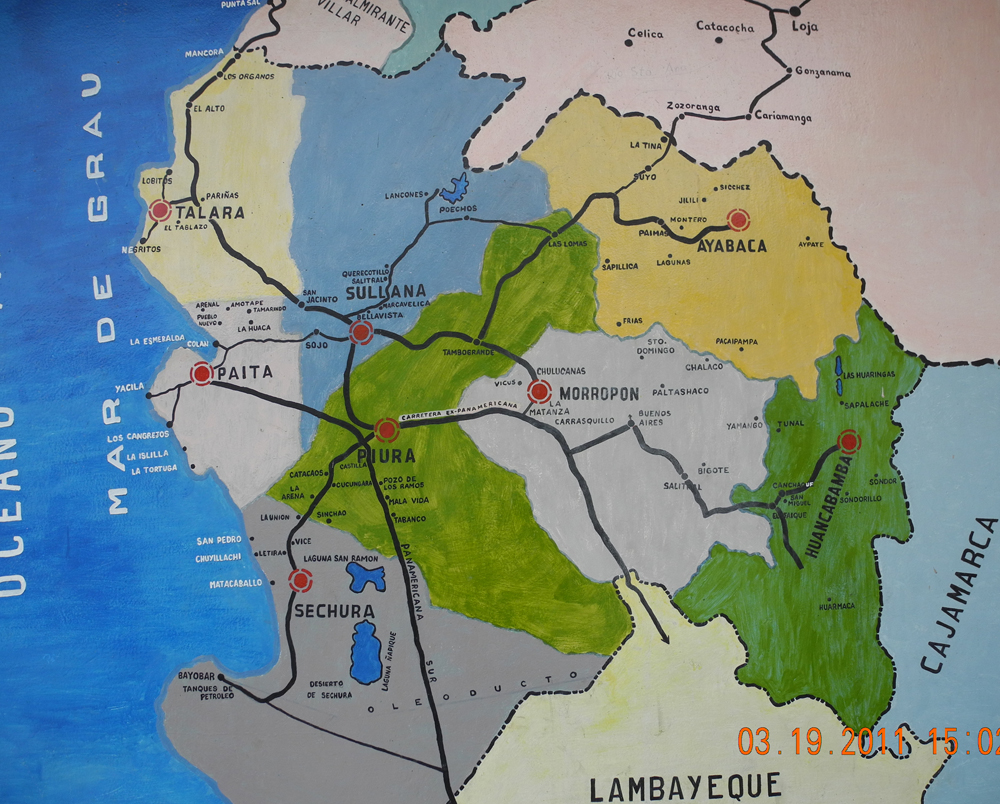 |
Figure 2. Map of department Piura, Peru, where Jaltomata cuyasensis grows. Photo by T. Mione, March 2011.
Movie of cloud forest in northern Peru Bosque de Cuyas. The roadsides through this forest are habitat for Jaltomata cuyasensis (movie by Thomas Mione, 37 seconds, 43.3 MB, March 2011; in this movie the first person is Segundo Leiva G. and the second person is Leon Yacher). |
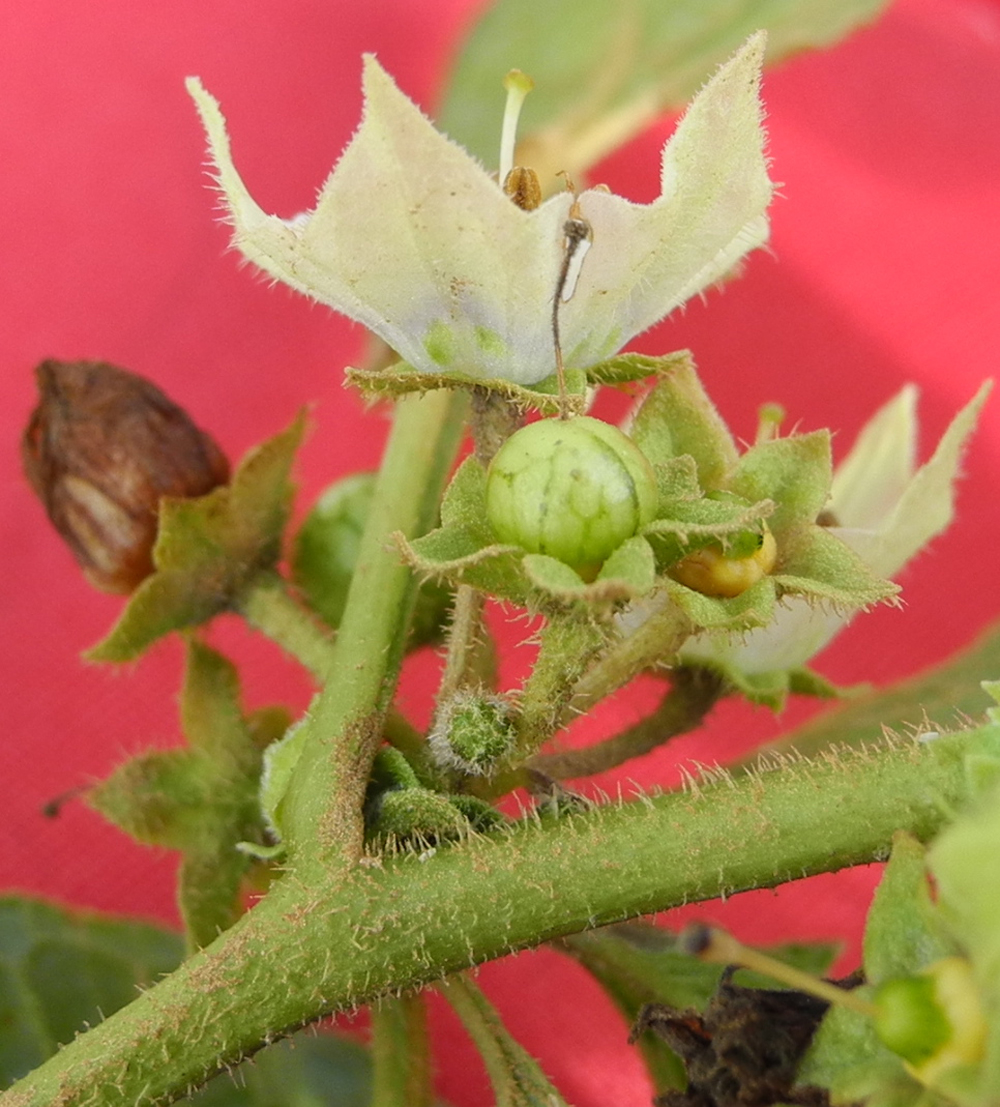 |
| Figure 3. Jaltomata cuyasensis. Unripe fruit with persistent style in foreground of flower with both flower and fruit shown in side view. Note the vestiture of non-gland-tipped finger hairs on the stem. Photo by T. Mione, March 2011, Mione, Leiva G. and Yacher 806. |
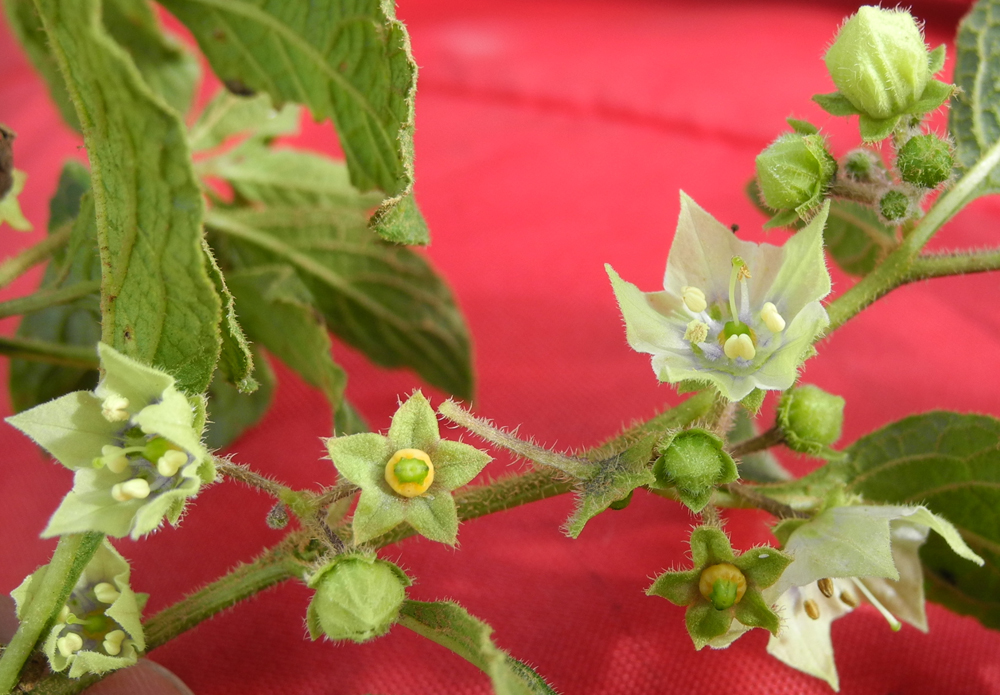 |
Figure 4. Jaltomata cuyasensis. The corolla-androecium has fallen off of the flower located just left of center, revealing the adaxial face of the calyx and the disk (orange) around the base of the ovary. The flower located to the right of center shows two dehisced anthers and three undehisced anthers. A flower bud can be seen at far upper right.
Photo by T. Mione, March 2011, Mione, Leiva G. and Yacher 806. |
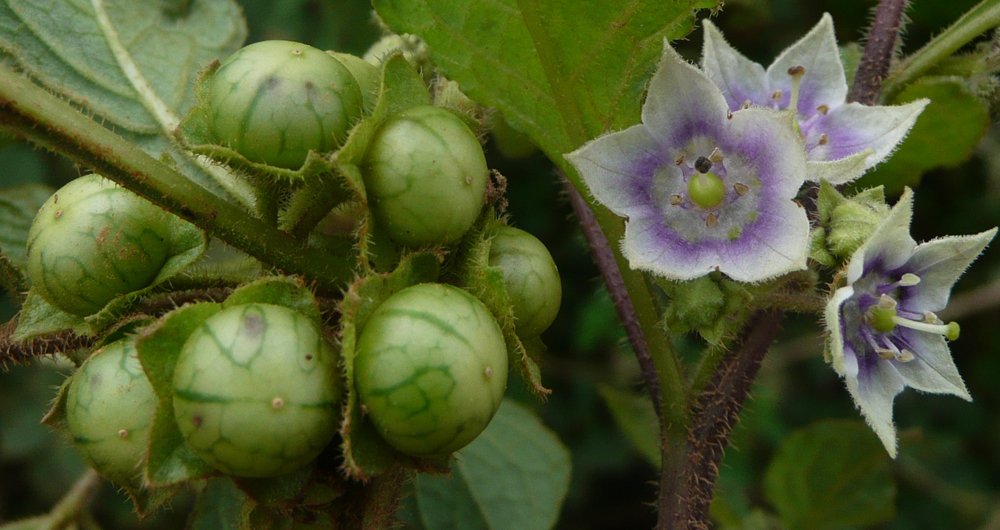 |
Figure 5. Jaltomata cuyasensis. Unripe fruits on left. In one population we found both functionally hermaphroditic flowers as shown in figures 1, 3 and 4, and flowers that were male-sterile and lavender in color shown on the right side.
Photo by Segundo Leiva G., March 2011, Leiva G., Mione & Yacher 5092. |
| Character |
Description of Jaltomata cuyasensis |
Figures on this page |
Habit & Height |
Shrub to 1.1 m high (to 1.5 m, Quipuscoa et al. 725) |
8 |
Branches, young |
purple, angular in cross section, sparsely pubescent with non-gland-tipped finger hairs |
7 |
older |
nearly round in cross section, to 14 mm diam |
7 |
| Leaves, size |
alternate sometimes appearing opposite,
to 13.5 cm long X 10 cm wide |
6 |
| shape |
eliptical, membranous, basally decurrent,
the apex acute, entire |
6 |
| hairs |
underside nearly glabrous, the hairs concentrated on veins and non-gland-tipped; upperside pilosulose the finger hairs not gland-tipped |
7 |
| petiole |
to 4.6 cm, usually shorter |
6 |
Inflorescence |
umbellate, to 14-flowered according to protologue |
1, 3, 4, 5, 6, 9,10 |
peduncle |
green, pubescent with erect non-gland-tipped finger hairs |
4, 6 |
pedicel |
nearly terete, the raised longitudinal ridges visible with hand lens |
3, 4, 5, 6, 9, 10 |
| Calyx at flowering |
green on adaxial (corolla) side, stellate in outline; the margin cilate with unbranched (finger) hairs, the abaxial (back) face pubescent with finger hairs |
1, 3, 4, 6, top of 9, 10 |
| at fruit maturity |
|
5 |
Corolla color |
usually white, sometimes purplish,
with 5 pairs of green maculae in throat |
1, 3, 4, 5, 6, 9, 10 |
shape and size |
broadly crateriform-infundibular ("rotácea" in protologue); 1.5 - 2 cm diam |
1, 3, 4, 5, 6, 9, 10 |
lobes/lobules |
5 lobed (Figure 5) or lobes alternating with small lobules (Figure 9 and as described in protologue) |
1, 3, 4, 5, 6, 9, 10 |
hairs |
inner face seems glabrous with hand lens,
outer face has finger hairs |
1, 3, 4, 5, 9, 10 |
radial corolla thickenings |
no |
|
| Stamen, length including anther |
4.4 - 4.8 mm long (protologue), pilose at base (Figure 9) |
1, 3, 4, 5, 6, 9, 10 |
| filaments |
2.5 - 2.8 mm long (protologue), pilose at base (Figure 9) |
1, 4, 5, 9, 10 |
| anther color & length |
1.9 - 2 mm long (protologue), yellowish to cream colored |
1, 4, 10 |
| anthers of a flower open simultaneously? |
no |
1, 4, 10 |
| pollen quantity per flower |
88,750 -
138,500 |
flowers of Mione et al. 806 collected in Peru (not grown for study), n = 2 flowers, counts by CCSU students
Elisabeth dos Santos and Emmett Varricchio |
| pollen grain size |
add this data |
|
Stigma |
green, bilobed |
1, 3, 4, 5, 9, 10 |
Style |
3.5 - 5.1 mm long (protologue), off-white |
1, 3, 4, 5, 9, 10 |
Ovary |
green, glabrous, the disk bright yellow and 60% of the height of the ovary in side view |
1, 4, 5, 9, 10 |
Ovules per ovary |
78 |
n = 1 flower, Mione et al. 806 |
| Nectar |
transparent |
1 |
| Herkogamy |
yes, a few mm |
1, 4, 5, 9, 10 |
| Protogyny |
no data |
|
Fruit color (at maturity) and size |
orange, 5-6 mm X 8-9 mm |
5 |
Seeds per fruit |
78 (protologue) |
|
Seed Size |
|
|
Chromosome number |
no data |
|
Growability in Connecticut, USA |
no data |
|
How long does it take from flower to ripe fruit? |
no data |
|
Self-Compatible? |
no data |
|
Seed Germination |
no data |
|
Ratio of pollen to ovules |
1776 (138,500 / 78) |
n = 1 flower, Mione et al. 806 |
| Character |
Description of Jaltomata cuyasensis |
Figures |
Geographic and Altitudinal Distribution of Jaltomata cuyasensis
| Department |
province |
locality |
elevation |
habitat |
date |
collector |
Data Entry |
| Piura |
Ayabaca |
montaña de Cuyas |
2,420 |
bosque húmedo montano |
5 June 1996 |
TYPE: V. Quipuscoa S. et al. 725 (Holotype: HAO; Isotypes: CORD, F, MO) |
Apr 2011 |
| Piura |
Ayabaca |
Bosque de Cuyas |
2,480 |
borde de carretera |
21 Sept 1996 |
S. Leiva & V. Quipuscoa 1870 (F, HAO) |
Apr 2011 |
| Piura |
Ayabaca |
alrededores del Bosque Cuyas, S 4 37', W 79 42" |
2,690 |
borde de carretera entre Alnus acuminata |
06 July 1997 |
S. Leiva, N. Sawyer & V. Quipuscoa 2025 (HAO) |
Apr 2011 |
| Piura |
Ayabaca |
8 km NE of Ayabaca above Las Cuyas, S 4 37', W 79 42" |
2,600 |
in quebrada |
06 June 1997 |
N. W. Sawyer & S. Leiva 801 (HAO) |
Apr 2011 |
| Piura |
Ayabaca |
S 04 38' 41.8"
W 79 43' 39.2" |
2,750 |
roadside man-made embankment |
20 March 2011 |
Leiva, Mione & Yacher 5092;
Mione, Leiva & Yacher 806
|
Apr 2011 |